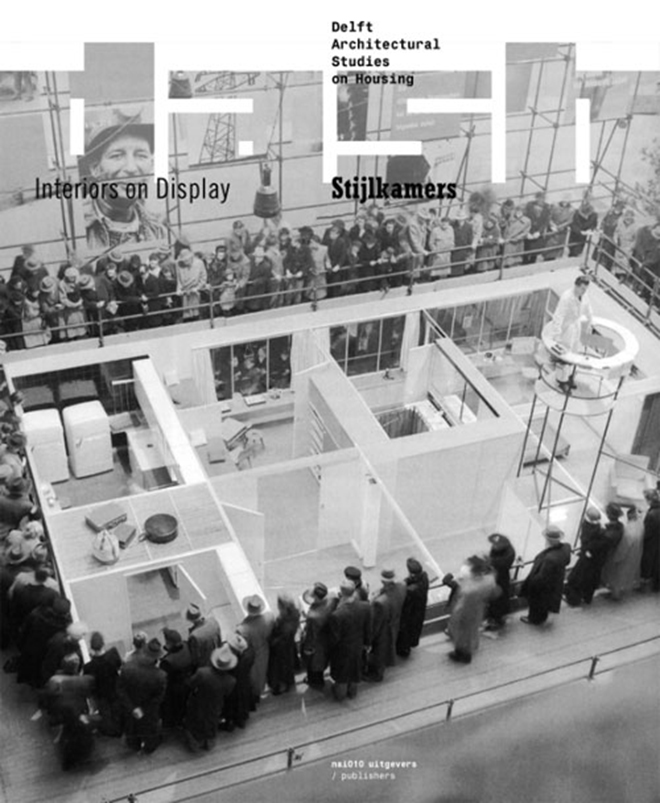Redactioneel
DOI:
https://doi.org/10.7480/dash.11.4955Samenvatting
De omslag van DASH nr. 11 toont een woninginterieur dat in 1952 tentoongesteld werd in Berlijn op de tentoonstelling ‘Wir bauen ein besseres Leben’ / ‘We’re Building a Better Life’. In dit modelinterieur, vormgegeven als een stralend wit laboratorium, deden Amerikaanse acteurs aan het toegestroomde Berlijnse publiek voor hoe er gewoond moest worden in een dergelijk huis. Een deskundige in witte jas, die boven het grauwe publiek uittorende, voorzag het huis en de handelingen van de acteurs van uitleg.
Als geen ander beeld toont deze foto hoe het woninginterieur in de moderne tijd is aangegrepen als instrument in emancipatoire en politieke processen, van buiten af én van binnen uit, die het wonen drastisch hebben veranderd. Met de opkomst van de massawoningbouw in de vorige eeuw is het wonen onmiskenbaar een architectonische opgave geworden en het interieur speelt daarbij een belangrijke rol. Men kan zich echter afvragen of het woninginterieur wel een architectonische opgave kan zijn. Binnen de vier muren van het eigen huis gaat de bewoner immers zijn gang, ongezien en ongestoord, waarbij de muren het private van het publieke scheiden. Het huis wordt ingericht en aangepast naar eigen wensen, gedecoreerd met de parafernalia van het dagelijks leven en de herinneringen aan het verleden. Dit persoonlijke ten spijt, laat de geschiedenis zien dat het wooninterieur ook altijd aan representatie verbonden is en daarmee per definitie een architectonische opgave: denk alleen al aan de interieurs van grote woonhuizen en adellijke paleizen. De opkomst van de massawoningbouw in de laatste 100 jaar heeft het wonen als architectonische opgave centraal gesteld en daarmee ook aan het woninginterieur de ruimte gegeven om een opgave te worden, die de adellijke elite en het decoratieve voorbij is gestreefd.
Tegenwoordig lijkt ieder interieur gezien te worden als ‘architectonisch’, of beter nog, ‘design’-project: men hoeft slechts in een willekeurige kiosk rond te kijken om te zien hoe de woonconsument overspoeld wordt met informatie over de laatste trends. Het interieur lijkt meer dan ooit een middel geworden waarmee een individu zichzelf aan de wereld presenteert, zoals de mode dat ook doet.
Voor DASH is deze aandacht voor het woninginterieur interessant, omdat al dan niet expliciet geformuleerde ideeën over het interieur altijd een rol spelen (en gespeeld hebben) bij het ontwerpen van woningen, niet alleen bij het ontwerp van privé woonhuizen, maar ook binnen de massawoningbouw. De overdracht van deze ideeën vond (en vindt) voornamelijk plaats via de interieurs zelf, die door de media (boeken, tijdschriften, kranten, televisie, films, tentoonstellingen, warenhuizen, catalogi, woon-blogs) publiek gemaakt worden. Een deel van deze interieurs is speciaal gemaakt om een specifieke opvatting over wonen en architectuur uit te drukken. Op deze tentoongestelde woninginterieurs, die we hier ‘stijlkamers’ noemen, richten we ons in dit nummer van DASH.
Voor dit nummer hebben we 15 stijlkamers onderzocht uit de afgelopen eeuw, interieurs die nooit zijn bewoond, maar wel getoond op tentoonstellingen en beurzen. In de meeste gevallen zijn de interieurs weer afgebroken en restten alleen tekeningen en/of foto’s. Voorafgaand aan deze documentatie bieden vijf essays en een interview verschillende perspectieven op het interieur als architectonische opgave, als commercieel object, en als instrument in kunstzinnige, avant-gardistische en culturele reflecties op de maatschappij. DASH biedt daarmee een kleine dwarsdoorsnede over 100 jaar wonen in de context van de sterk veranderende (westerse) samenleving en laat zien op welke manier dit architectonisch geprojecteerd is in het interieur.



